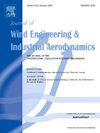校准通过管道系统测量的压力:管式响应测量与风洞试验之间的实验室环境变化说明
IF 4.2
2区 工程技术
Q1 ENGINEERING, CIVIL
Journal of Wind Engineering and Industrial Aerodynamics
Pub Date : 2024-11-23
DOI:10.1016/j.jweia.2024.105962
引用次数: 0
摘要
在风洞试验过程中,通过管道系统对结构进行精确的压力测量对于风载荷的精确估算至关重要。传统的校准研究主要关注管道配置对压力失真的影响,但往往忽略了在测量管道响应和结构气动压力之间环境参数变化的影响。然而,较高的大气压力和较低的环境温度会大大增加油管响应失真。为解决这一问题,本研究引入了一种动态校准方法,以考虑此类实验室环境变化。这种方法将在特定环境条件下获得的实验传递函数与环境变化影响的数值估算相结合,从而得出理想环境条件下的传递函数。在两种不同的环境条件下,使用实验和数值传递函数验证了这种方法的有效性。一项针对室外开路实验室的案例研究表明,在动态压力校准过程中忽略环境条件可能导致建筑物表面各通道峰值压力的整体平均偏差高达 ≈ 5%,局部最大偏差分别达到 ≈ 10%。因此,建议的校准方法可以显著提高通过管道系统进行压力测量的准确性,尤其是在不同环境条件下测量管道响应和压力时。本文章由计算机程序翻译,如有差异,请以英文原文为准。
Calibration of pressures measured via tubing systems: Accounting for laboratory environmental variations between tubing response measurement and wind tunnel testing
Accurate pressure measurements on structures via tubing systems during wind tunnel tests are crucial for precise estimation of wind loads. While calibration studies have traditionally focused on the contribution of tubing configuration to pressure distortion, they often overlook the effects of environmental parameter changes between the measurement of tubing response and aerodynamic pressure on structures. However, higher atmospheric pressure and lower ambient temperature can substantially increase tubing response distortion. To address this, this study introduces a dynamic calibration approach that accounts for such laboratory environmental changes. This method integrates the experimental transfer function, obtained under specific environmental conditions, with numerical estimates of the impact of environmental changes, to derive transfer functions for the desired environmental conditions. The effectiveness of this approach was validated using experimental and numerical transfer functions under two distinct environmental conditions. A case study for outdoor open-circuit laboratories revealed that neglecting environmental conditions during dynamic pressure calibrations could lead to overall average deviations in peak pressures across the channels on a building face of up to ≈ 5%, with local maximum deviations reaching ≈ 10%, respectively. Therefore, the proposed calibration method can significantly enhance the accuracy of pressure measurements via tubing systems, particularly when the tubing response and the pressures are measured under different environmental conditions.
求助全文
通过发布文献求助,成功后即可免费获取论文全文。
去求助
来源期刊
CiteScore
8.90
自引率
22.90%
发文量
306
审稿时长
4.4 months
期刊介绍:
The objective of the journal is to provide a means for the publication and interchange of information, on an international basis, on all those aspects of wind engineering that are included in the activities of the International Association for Wind Engineering http://www.iawe.org/. These are: social and economic impact of wind effects; wind characteristics and structure, local wind environments, wind loads and structural response, diffusion, pollutant dispersion and matter transport, wind effects on building heat loss and ventilation, wind effects on transport systems, aerodynamic aspects of wind energy generation, and codification of wind effects.
Papers on these subjects describing full-scale measurements, wind-tunnel simulation studies, computational or theoretical methods are published, as well as papers dealing with the development of techniques and apparatus for wind engineering experiments.

 求助内容:
求助内容: 应助结果提醒方式:
应助结果提醒方式:


